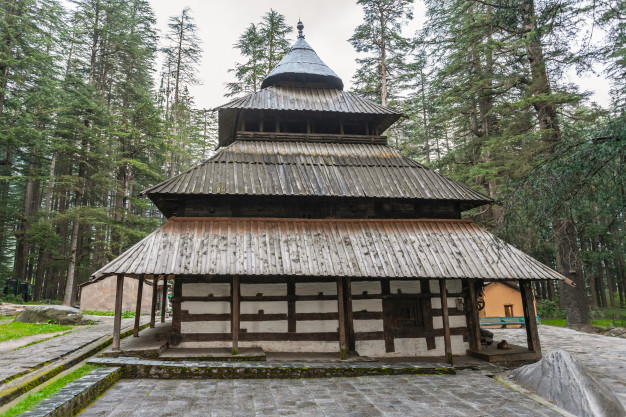The Hidimba Devi, or Hadmiba temple, also known as the Dhungiri temple, is one of the most popular temples in Manali. The temple is a four-storied structure located amidst a forest known as Dhungri Van Vihar. The locals gave the temple the name of the surrounding forest area. The temple, built in 1553, is dedicated to Goddess Hadimbi, wife of Bheem, one of the five Pandavas in the Mahabharata. The top conical construction is made of metal, whilst the other three square-shaped floors sport timber tile roofing. You can also find a high tower that is 24m tall.

Popular Hindu legend has it that Hadmiba did tapasya (medidation) in the region of Dhungri near Manali and attained supernatural powers after meditation. Her kindness towards the Dhungri locals made her immensely popular and thus a ‘pagoda’ style temple was erected to worship her. About 70 m from this temple, you will find another shrine dedicated to the warrior-ruler Ghatotkachh, who was born to Bheem and Hadimba.
The Hidimba Devi temple houses a wooden doorway and mud walls adorned with stonework. The door contains intricate miniature paintings of the Goddess and other animate objects. The beam of the doorway features the Navgrahas and female dancers from the mythical tales of Lord Krishna. The temple does not house any idol of the Goddess, but a large stone sporting her footprint is placed inside it.
The temple hosts an annual festival with great favour and zest, during the Hindi month of Shravan, in the memory of Raja Bahadur Singh, who constructed this temple. This fair is called as ‘Bahadur Singh Re Jatar’ by the locals. There is another fair that is held annually on the 14th of every May falling on the birthday of Hadimba Devi. This festival is marked by musical celebration and dance performed by the local womenfolk who visit the Dungri forest area.
This temple that is about five centuries old organizes a fair on the day the temple was originally raised known as the ‘Sarrohni Mela’ in the first Shravan month. This fair coincides with the completion of paddy grafted into the land.

